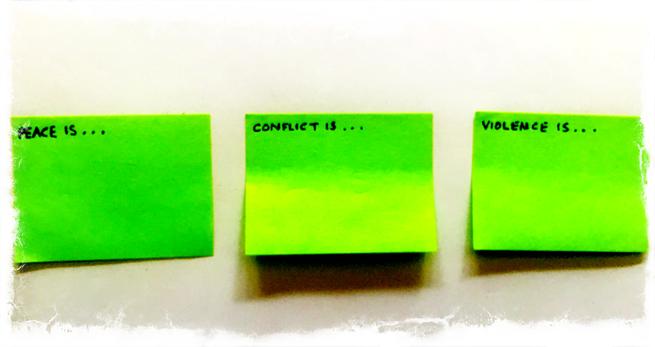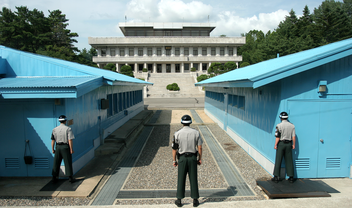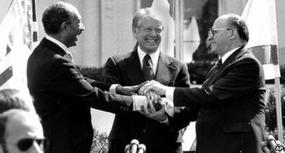‘As Peace, am I not praised by both men and gods as the very source and defender of all good things? What is there of prosperity, of security, or of happiness that cannot be ascribed to me? On the other hand, is not war the destroyer of all things and the very seed of evil?’
Desiderius Erasmus, The Complaint of Peace
In this lesson we are going to consider exactly what we mean by the terms peace, conflict and violence. Peace, in particular, is a contested concept and has been defined in a number of ways. You have three post-notes in front of you. On each note write a definition of each term and add it to the appropriate section on the wall of the classroom.

Distinguishing between positive peace and negative peace
If we consider peace in very simplistic terms, and we accept the proposition (whether true or not) that peace and war are opposites, then we could define peace simply as the absence of war.
This is referred to as a NEGATIVE DEFINITION of peace (negative because it refers to the absence of something, in this case, war).
However, the KROC Institute for International Peace Studies has argued that a more appropriate definition of peace would be not only the absence of war ‘but also the presence of the conditions for a just and sustainable peace, including access to food and clean drinking water, education for women and children, security from physical harm, and other inviolable human rights’.
This would be a POSITIVE DEFINITION of peace.
Case Study Activity:
So, we can see that defining peace is not as easy as perhaps we thought. Let’s look at a few case studies and decide whether or not we would describe them as real peace.
Example 1:

We could think of peace in terms of a narrow version, which implies the ending of violence but not resolving its underlying causes.
The current situation in Cyprus where Greek and Turkish Cypriot military forces, or Korea where North and South Korean forces, confront each other daily across a demilitarized line might be described as peace, according to this framework
Example 2:

We could think of peace in terms of a broad version that would produce a peace agreement, peaceful state, and society according to a single universal model.
The European Union’s emergence from the ruins of World War II might be an example, where very similar states have emerged
Example 3:

Finally, we could think in terms of multiple versions of peace which would imply the coexistence, but simultaneous agreement to differ, of very different social and political systems.
Perhaps the peace agreement between Egypt and Israel in 1978 is a good example of this approach, in which very different states and their population, with many remaining and deep disagreements and difference, are reconciled, to a limited degree
For each of the examples given, discuss whether you would agree whether or not it shows peace.
If not, what would need to change?
If you are unfamiliar with the case studies then you may spend time looking at a little background research.
Reading Activity:
Read the following extract from ‘Peace: A Very Short Introduction’ – Richmond, O (1997), OUP, Oxford. Use the questions that follow as a framework for class/small group discussion.
‘Each of these versions of peace offers different levels of security and rights for society: a narrow version would be basic but relatively insecure, a broader version more complex but also more sustainable, and a multiple approach even more complex but stable. Underlying each type is a central question: does one make peace by subjugating one’s enemies, assimilating them by converting them into something similar to the dominant group, or by accepting, and thus becoming reconciled to their difference?’
According to Johan Galtung, one of the founders of modern peace studies, a ‘negative peace’ is the aim of narrow versions (which would be a good description of the failed peace treaty after World War I), a ‘positive peace’ the aim of broader versions (which may well explain the European Peace after World War II). A more recent concept, a ‘hybrid peace’, is the amalgam of multiple approaches (as may be emerging in places such as Timor Leste or Kosovo after the conflicts there in the late 1990s). A narrow understanding of peace indicates an absence of overt violence (such as warfare or low-intensity conflict) both between and within states. This may take the form of a ceasefire, a power-sharing agreement, or exist within an authoritarian political system. It indicates that one state, or group in society, dominates another through violence or more subtle means. This approach has the benefit of simplicity, but a negative peace will always be fragile because it is based on ever-shifting configurations of power in the international system or within the state. Hidden, so-called ‘structural violence’ embedded in social, economic, and political systems remains unaddressed. This might explain why, after various ceasefires in the 2000s, the peace process has collapsed in Colombia on several occasions, because the core issues of the dispute, in particular relating to land distribution, poverty, and socio-economic inequality, have not as yet been addressed. A peace agreement based on a narrow understanding of peace would probably not be satisfactory in anything other than the short term. Military force or an authoritarian government may maintain a basic security order—as in East Germany during the Cold War—but many deficits relating to human rights, democratic representation, and prosperity remain.
These remaining issues are markers of structural violence—meaning the indirect violence that is created by oppressive structures of government, of law, bureaucracy, trade, resource distribution, social class, or because of poverty or environmental problems. Sometimes structural violence can occur even in relatively peaceful societies.’
- Does one make peace by subjugating one’s enemies, assimilating them by converting them into something similar to the dominant group, or by accepting, and thus becoming reconciled to their difference?
- What is the relationship between simplicity and fragility when considering the importance of how we define peace? How might this relate to time considerations – short, medium and long term etc?
- How can we distinguish between different types of violence (overt vs. structural?)
- What case studies can we use to relate our learning in this extract?
Conclusion:
Now, revisit your definitions of peace, conflict and violence you created at the start of the lesson. What has changed? How? Why?